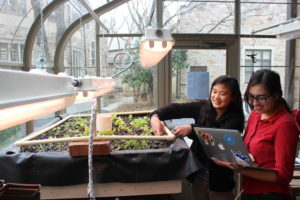Do-it-yourself Aquaponics

To view the photo-rich magazine version, click here.
Originally appears in the Fall 2018 issue.
EVERY YEAR in my science classes I hear the resounding opinion that humans are disastrous. Most students seem resigned to a view that humans necessarily have a dysfunctional relationship with the rest of the natural world. Two of the things that have helped me and my students consider an alternate view of our potential include reading sections of Robin Wall Kimmerer’s book Braiding Sweetgrass and building our own aquaponics system. The first offers an inspiring vision for how humans can live in relation to each other and the rest of the natural world; the second has given us hands-on experience with designing a system that better mimics the negative-feedback, zero-waste systems of the natural world.
When discussing the dire conditions of environmental degradation, it has been important for my students and me to find examples that seek to address them. As Rabbi Nina Beth Cardin, a local interfaith environmental leader, inspired us when she joined a past Earth Day panel at our school, we need new design thinking to approach our environmental challenges. Instead of asking, what is the responsible thing to do with our waste, for example, we need to design systems that have no waste. Nature knows no waste, and our human-designed systems need to follow that inspiration. Aquaponics, the simultaneous growing of fish and leafy greens, is one example of a system that takes this core principle to heart. While it is not problem-free and will not solve every issue in the food system, it is an example of an innovative design solution to an old problem, and one that lends itself well to understanding and building with high school students.
Last June the senior students with whom I first started building our own campus aquaponics system four years ago graduated. This past school year a group of 9th- to 12th-graders worked with me to operate our old system, and to build a second small aquaponics system of an alternate design inside our small greenhouse. Building these systems with students has been among my most rewarding learning experiences. What follows is the story of how this journey began and developed along the way.
This content is restricted to subscribers only.
If you are not yet a subscriber, please consider taking out a subscription here.
If you are an existing subscriber, kindly log in or contact us at info@greenteacher.com for more information.





